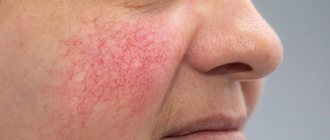A lump in the throat during neurosis is the first signal that malfunctions are occurring in the functioning of the nervous system. Patients who have problems with swallowing and sore throat seek help from many specialists, but few of them associate these symptoms with psychosomatics. “Pharynx neurosis” refers to a pathology that affects the funnel-shaped canal - the link between the mouth and the esophagus.
Symptoms that something is wrong with your throat
The feeling of a lump in the throat may be accompanied by a “soreness” in the throat, a feeling of incomplete inhalation, difficulty swallowing, discomfort in the neck and chest, a burning sensation or a sensation of a foreign body, although there are no changes when palpated (nothing is enlarged, not deformed, not inflamed).
A “lump” that appears once should not cause concern, since it is most likely a one-time reaction of the body to stress, overwork, or excitement of the nervous system.
If this phenomenon recurs, you should consult a doctor, as this feeling can become a painful symptom, “overgrown” with other manifestations: a feeling of a foreign body in the oropharynx, sleep disturbances, anxiety, loss of appetite and disruption of normal swallowing, surges in blood pressure and sensations of heart failure , diarrhea or constipation.
As a rule, timely and adequate treatment completely eliminates the unpleasant symptom.
Causes of the disease
The occurrence of any nervous disease is not one reason, but a combination of them. And throat neurosis is no exception. There are three forms of neurosis: anesthesia, hyperesthesia and paresthesia. All three species have different factors that contribute to the development of the disease.
1. Anesthesia.
Anesthesia of the pharynx is characterized by complete or partial loss of sensitivity and disruption of the swallowing process. The following factors lie at the root of this disease:
- hysteria or severe stress;
- brain tumors;
- all types of paralysis;
- syphilis;
- infections. For example, influenza, measles, diphtheria or typhus;
- problems with the spine. Another reason for the development of pharyngeal neurosis is incorrect posture and osteochondrosis of the cervical spine.
2. Hyperesthesia.
This increases the sensitivity of the throat. Its appearance can be caused by the following reasons:
- throat diseases. This includes tonsillitis, laryngitis and pharyngitis, as well as other inflammatory processes in the trachea, larynx and pharynx;
- bad habits. An unhealthy lifestyle, namely drinking alcohol and smoking, can lead to throat neurosis;
- neurasthenia. A person who is under the influence of severe stress often complains of pain, soreness, scratching and spasm in the throat. These listed symptoms are the main ones in the diagnosis of pharyngeal neurosis.
3. Paresthesia.
It can cause a wide variety of sensations, as in hyperesthesia and anesthesia, but numbness and tingling are added to the clinical picture. The causes are considered to be:
- menopause is the main factor in females;
- suspiciousness. Very often the disease manifests itself in people who are unbalanced and irritable. Based on the form of throat neurosis, the symptoms of the disease are also distinguished.
Causes of an unpleasant lump in the throat
- Overwork.
- Severe or long-term stress. Nervous tension.
- Neuroses and neurotic reactions.
- Depression.
- Anxiety disorder (phobias, panic attacks, generalized anxiety disorder, etc.)
- Psychosomatic diseases.
- Schizotypal disorder, schizophrenia.
- Consequences of organic damage to the nervous system after trauma. infections, strokes, heart attacks, etc.
- Diseases of internal organs (hyperthyroidism, thyroiditis, tonsillitis, spinal osteochondrosis, hiatal hernia, obesity or cachexia).
- Allergic reactions.
- Poisoning.
Who to contact if you have a lump in your throat
The feeling of a lump in the throat is treated by a psychotherapist or psychiatrist. During the consultation, the doctor will assess the condition and determine the amount of assistance needed.
Help can be obtained in any clinic where there is a license to provide assistance in psychotherapy, psychiatry and neurology and where a psychiatrist or psychotherapist conducts an appointment.
ROSA Clinic
is a specialized and licensed clinic that provides assistance for all types of disorders accompanied by a feeling of a lump in the throat.
Our specialists
are ready to come to your home for consultation; you can also see a doctor in our clinic.
Treatment is most often carried out at home. If necessary, it is possible to be hospitalized in our own hospital, equipped with modern diagnostic equipment and where it is possible to carry out active treatment.
When your throat hurts...
And this is how infectious and non-infectious causes of pain in the throat are distinguished:
- Infectious causes:
— Viral 70% (rhinoviruses, coronoviruses, adenovirus, influenza and parainfluenza viruses…) — Bacterial 15%. The most common cause is Group A B-hemolytic streptococcus (GABHS) - Fungal. The main causative agent is representatives of the genus Candida. The most pathogenic Candida albicans is 50% of all cases!
- Non-infectious causes:
— Allergic — Traumatic: cold drinks, ice cream, hot food, tobacco smoke from active and passive smoking, excessive consumption of spices, mustard, horseradish — Burns and injuries of the larynx
— Neuralgic conditions
— Benign and malignant neoplasms;
— Diseases of other human organs and systems
— Exposure to an irritating factor: gastroesophageal reflux, postnasal drip
Infectious causes of pain
Viral causes include primarily acute respiratory diseases, infectious mononucleosis, influenza, measles, and rubella. In addition to pain in the throat, the patient complains of the following symptoms: headaches, runny nose, nasal congestion, cough, fever, weakness, loss of appetite. Etiological diagnosis is difficult, especially in routine practice. In this situation, doctors are forced to rely on literature data. In most cases (20-30%), it is not possible to accurately identify the virus that caused the disease in a given person. Data from successful verification of the diagnosis place rhinoviruses in 1st place in the etiology of ARVI of the upper respiratory tract (30-50%). It should be noted that the influenza virus causes only 5 to 15% of cases of all acute respiratory viral infections.
Lesions of bacterial etiology are the cause of a sore throat in 50% of cases. Bacterial infections are most often localized in the tonsil area (acute tonsillitis). Their characteristic symptoms are: severe pain in the throat; weakness and decreased performance; increased body temperature; redness of the palate, white plaque on the tonsils; enlarged lymph nodes.
Pharyngomycosis in the vast majority of cases is caused by yeast-like fungi of the genus Candida (oral thrush). Sometimes the causative agents are mold fungi (aspergillus, penicillin, geotrichum). To trigger the pathological growth of fungi, which leads to an inflammatory process, it is necessary to reduce the body's defenses. Therefore, pharyngomycosis accompanies the following diseases and conditions:
- long-term antibiotic therapy;
- diabetes;
- tuberculosis;
- metabolic diseases (obesity, thyroid pathology);
- oncological diseases (during chemotherapy);
- HIV.
The disease begins in the same way as all pharyngitis - with discomfort in the throat. The fungal nature of the process can be suspected based on the characteristic itching and burning. Patients complain of constant soreness and dry mouth. Pain for pharyngomycosis is very characteristic; it intensifies with swallowing and is more intense than with a bacterial infection.
Non-infectious causes of sore throat
Pain in the throat can be a result of exposure to various allergens: food, pollen, house dust, fur and secretions of pets, etc. In addition to discomfort and pain in the throat, patients are concerned about congestion and clear discharge from the nose, sneezing, itchy eyes .
Various external factors can cause pain: mechanical injuries to the larynx, chemical or thermal burns. Hard pieces of food and bones can injure the larynx. Chemical burns can be caused by inhaling vapors of harmful substances at work or by ingesting harmful substances while eating. Thermal burns most often occur when eating hot foods or drinks.
Pain in the throat may be a manifestation of neurological disorders. Usually this condition is accompanied by a feeling of a lump in the throat, difficulty swallowing, and headaches. This feeling can manifest itself constantly, or maybe with a certain frequency.
Other causes of sore throat accompanied by sore throat and cough: drainage of discharge from the nasopharynx due to adenoiditis or sinusitis, space-occupying formations of the nasopharynx (cyst/bursa of Thornwald); irritation of the respiratory tract by dry air, smoke, including active and passive smoking. In adults, a common cause of such complaints, often with a feeling of a lump in the throat, a “foreign body,” is an exacerbation of chronic pharyngitis associated with pathology of the gastrointestinal tract: gastritis, esophagitis, gastroesophageal reflux, cholecystitis, gastric ulcer. Severe dysphagia, regurgitation and pain when swallowing can be caused by varicose veins of the esophagus. Chronic pathology of the kidneys, endocrine system, blood, previous radiation and chemotherapy can lead to the formation of a chronic inflammatory and atrophic process in the pharynx. The first manifestation of hyperglycemia (increased blood sugar) may be thirst and dry mouth, accompanied by catarrhal changes in the pharynx. Similar complaints occur with Itsenko-Cushing syndrome. In patients with hypothyroidism, swallowing is often impaired, speech becomes slurred due to swelling and dryness of the tongue and lips, and it is difficult to perform pharyngoscopy.
Hypovitaminosis can also cause discomfort and pain in the throat. Vitamin A deficiency causes dryness and erosion of the mucous membranes. Vitamin B2 deficiency produces a triad of symptoms: dermatitis, cheilitis and glossitis (bright red, smooth and shiny dry tongue), accompanied by burning and pain in the mouth when talking and eating. Vitamin C hypovitaminosis occurs with dietary deficiency of ascorbic acid, inflammatory processes in the intestines and is manifested by pain, hemorrhagic and ulcerative-necrotic manifestations in the oral cavity and in the area of the palatine tonsils, mobility and tooth loss.
Diseases of the spine (cervical osteochondrosis, tuberculous spondylitis, radiculitis) can cause pain in the throat. Neuralgia of the glossopharyngeal nerve manifests itself as intense pain in the pharynx, especially against the background of chronic stress in anxious and suspicious patients. Metabolic disorders, intoxication, and trauma contribute to its occurrence. Characterized by unilateral pain in the root of the tongue, tonsil, lasting several minutes, accompanied by dry throat and subsequent hypersalivation. Neuralgia of the superior laryngeal nerve gives similar symptoms, but also includes a painful dry cough and spasm of the vocal folds when inhaling.
Diagnosis and treatment
As we can see, there are many reasons why your throat hurts. And to determine the real cause of this condition, an examination by an otolaryngologist is necessary. If during the diagnostic process with an ENT doctor it becomes clear that the problem is not from the ENT organs, you may need to consult related specialists: a neurologist, gastroenterologist, allergist, endocrinologist. In this case, the patient is sent for CT, MRI, ultrasound of the thyroid gland, gastroscopy, etc.
Every person who has a sore throat needs a medical examination and diagnosis. The sooner you make an appointment, the more effective the treatment will be, and the risk of complications will be minimal.
How is the feeling of a lump in the throat treated?
Treatment is determined by the causes and mechanism of development of the disease and is selected individually for each patient.
For a recent and non-severe condition
treatment is carried out on an outpatient basis: the doctor conducts a psychotherapeutic session, prescribes medications that the patient takes at home and periodically comes for follow-up consultations.
For moderate severity
- treatment in a day hospital is recommended: daily treatment procedures are carried out (drug infusions, physiotherapy, etc.), which take an hour and a half, but the patient lives at home and goes about his usual business. The average course of a day hospital is about 10 days.
In severe condition
hospitalization in a hospital is recommended. Due to intensive treatment, the condition can be stabilized already in the first hours of stay. The average length of hospital stay is 10 days (from 5 to 30 days depending on the severity of the condition and the body’s recovery abilities).
Main methods of treatment:
- Psychotherapy.
- Drug treatment (pharmacotherapy).
- Physiotherapy.
- Massage and manual therapy.
- Diet therapy.
- Biofeedback therapy.
Diagnostics
Diagnosing IBS is not easy; a thorough examination is necessary to rule out other somatic pathologies. The diagnostic program is quite individual and is selected depending on the existing symptoms. Generally, ECG, EEG, clinical blood/urine tests and consultation with specialists are generally recommended.
The main task of the doctor in the case of a tumor associated with diseases in the throat is to make a competent differential diagnosis, with the exception of malignant tumors or other organic changes in the throat. The main difference between a coma and IBS is that there is no problem swallowing food for some time immediately after sleep. Within a few minutes of waking up, there are no symptoms in the throat.
The doctor examines the palpability of the thyroid gland to rule out abnormalities.










